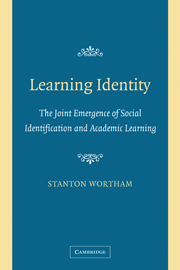Book contents
- Frontmatter
- Contents
- Acknowledgements
- 1 Self/Knowledge
- 2 Social Identification and Local Metapragmatic Models
- 3 Academic Learning and Local Cognitive Models
- 4 Tyisha Becoming an Outcast
- 5 Maurice in the Middle
- 6 Denaturalizing Identity, Learning and Schooling
- Appendix A Abbreviations of Names
- Appendix B Transcription Conventions
- References
- Index
4 - Tyisha Becoming an Outcast
Published online by Cambridge University Press: 05 June 2012
- Frontmatter
- Contents
- Acknowledgements
- 1 Self/Knowledge
- 2 Social Identification and Local Metapragmatic Models
- 3 Academic Learning and Local Cognitive Models
- 4 Tyisha Becoming an Outcast
- 5 Maurice in the Middle
- 6 Denaturalizing Identity, Learning and Schooling
- Appendix A Abbreviations of Names
- Appendix B Transcription Conventions
- References
- Index
Summary
In Mrs. Bailey and Mr. Smith's class, teachers and students developed two sets of overlapping metapragmatic/cognitive models during the year. Each involved an analogy between the classroom and one of the curricular themes, plus a series of participant examples that became important resources through which the analogy was established. Across each series of examples, together with other events, teachers and students developed metapragmatic/cognitive models that they used both to identify particular students and learn about a curricular theme. The metapragmatic and cognitive models were distinct in some respects, but they co-developed and came to overlap significantly as teachers and students used the same categories to identify students and to construe the curriculum.
The first such overlapping, local metapragmatic/cognitive model has already been introduced. The curricular theme involved the appropriate relation between an individual and society, with an analogy between society in general and the social organization of the classroom itself. The most salient category of identity in this model became the “disruptive outcast” category that was inhabited by Tyisha. This chapter traces in detail how Tyisha came to be a disruptive outcast and how a local cognitive model contributed to her emerging identity. The second model involved the curricular question of when an individual should accept the authority of those in power and when he or she should resist. Teachers and students developed an analogy between power relations in society and those in the classroom.
- Type
- Chapter
- Information
- Learning IdentityThe Joint Emergence of Social Identification and Academic Learning, pp. 148 - 216Publisher: Cambridge University PressPrint publication year: 2005



